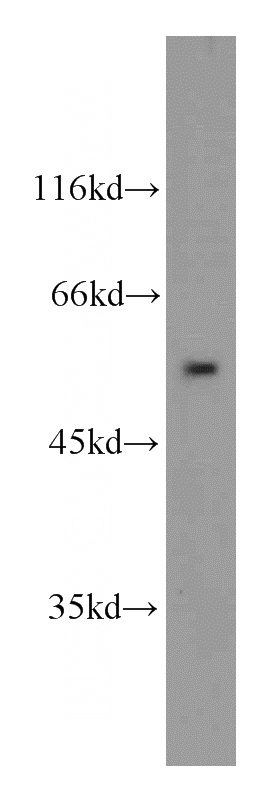-
Product Name
PNPLA3 antibody
- Documents
-
Description
PNPLA3 Rabbit Polyclonal antibody. Positive IP detected in HepG2 cells. Positive WB detected in HepG2 cells, human adipose tissue, Jurkat cells. Observed molecular weight by Western-blot: 53 kDa
-
Tested applications
ELISA, WB, IP
-
Species reactivity
Human; other species not tested.
-
Alternative names
Acylglycerol O acyltransferase antibody; Adiponutrin antibody; ADPN antibody; C22orf20 antibody; iPLA(2)epsilon antibody; iPLA2 epsilon antibody; PNPLA3 antibody
-
Isotype
Rabbit IgG
-
Preparation
This antibody was obtained by immunization of PNPLA3 recombinant protein (Accession Number: BC014449). Purification method: Antigen affinity purified.
-
Clonality
Polyclonal
-
Formulation
PBS with 0.1% sodium azide and 50% glycerol pH 7.3.
-
Storage instructions
Store at -20℃. DO NOT ALIQUOT
-
Applications
Recommended Dilution:
WB: 1:200-1:1000
IP: 1:200-1:1000
-
Validations

HepG2 cells were subjected to SDS PAGE followed by western blot with Catalog No:113981(PNPLA3 antibody) at dilution of 1:100

IP Result of anti-PNPLA3 (IP:Catalog No:113981, 4ug; Detection:Catalog No:113981 1:100) with HepG2 cells lysate 1000ug.
-
Background
PNPLA3(patatin-like phospholipase domain-containing protein 3), also named as ADPN, C22orf20, alternatively referred to as adiponutrin, encodes a 481-amino acid protein of 54 kDa that belongs to the patatin-like phospholipase domain-containing family. Despite the apparent absence of a membrane-spanning domain, PNPLA3 is tightly associated with membranes and it may be targeted specifically to regions of the ER membrane that are destined to become nascent lipid droplets(PMID:22338072). It is a multifunctional enzyme which has both triacylglycerol lipase and acylglycerol O-acyltransferase activities. Genetic variations in PNPLA3 are a cause of susceptibility to non-alcoholic fatty liver disease type 1 (NAFLD1). It has 2 isoforms produced by alternative splicing.
Related Products / Services
Please note: All products are "FOR RESEARCH USE ONLY AND ARE NOT INTENDED FOR DIAGNOSTIC OR THERAPEUTIC USE"
